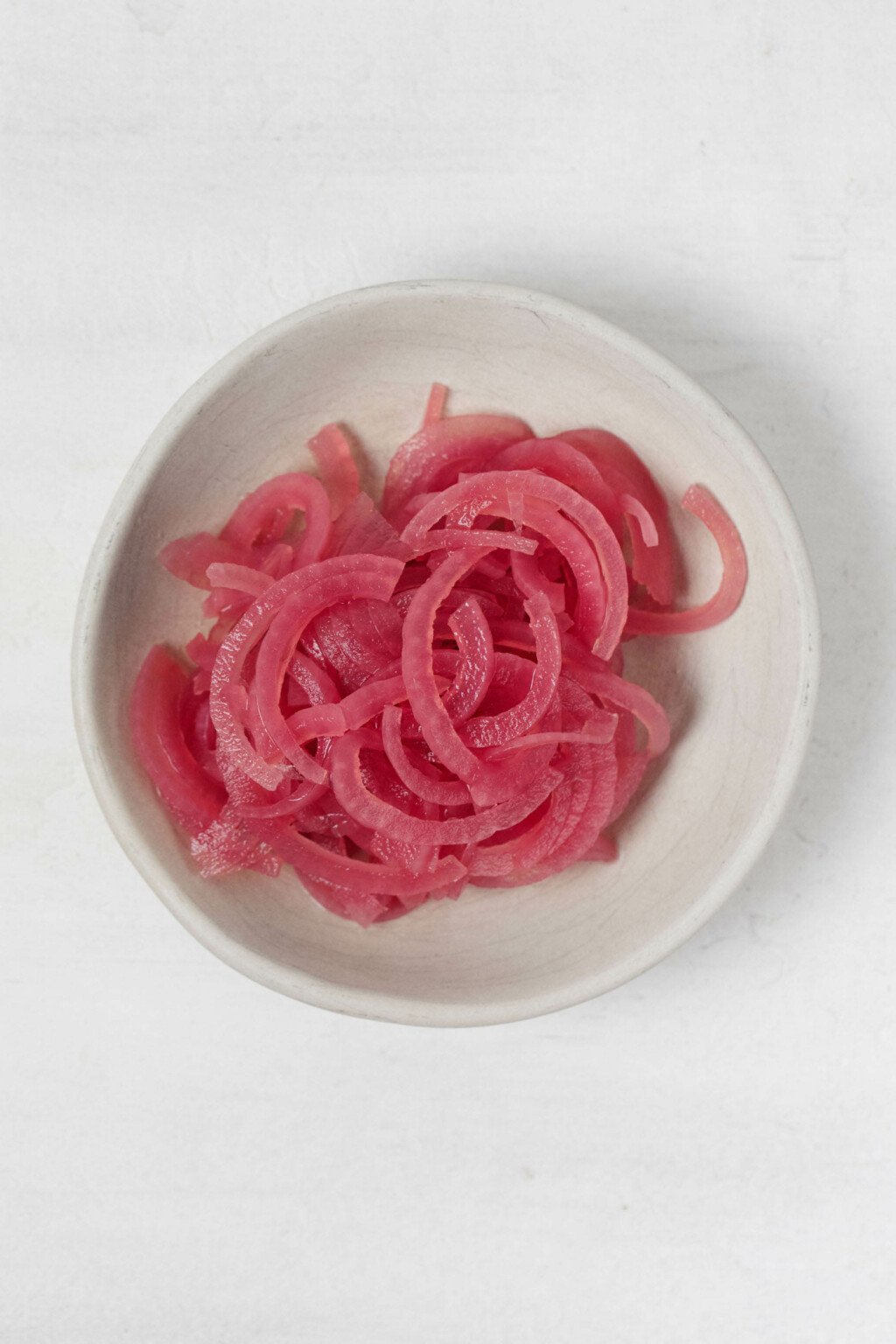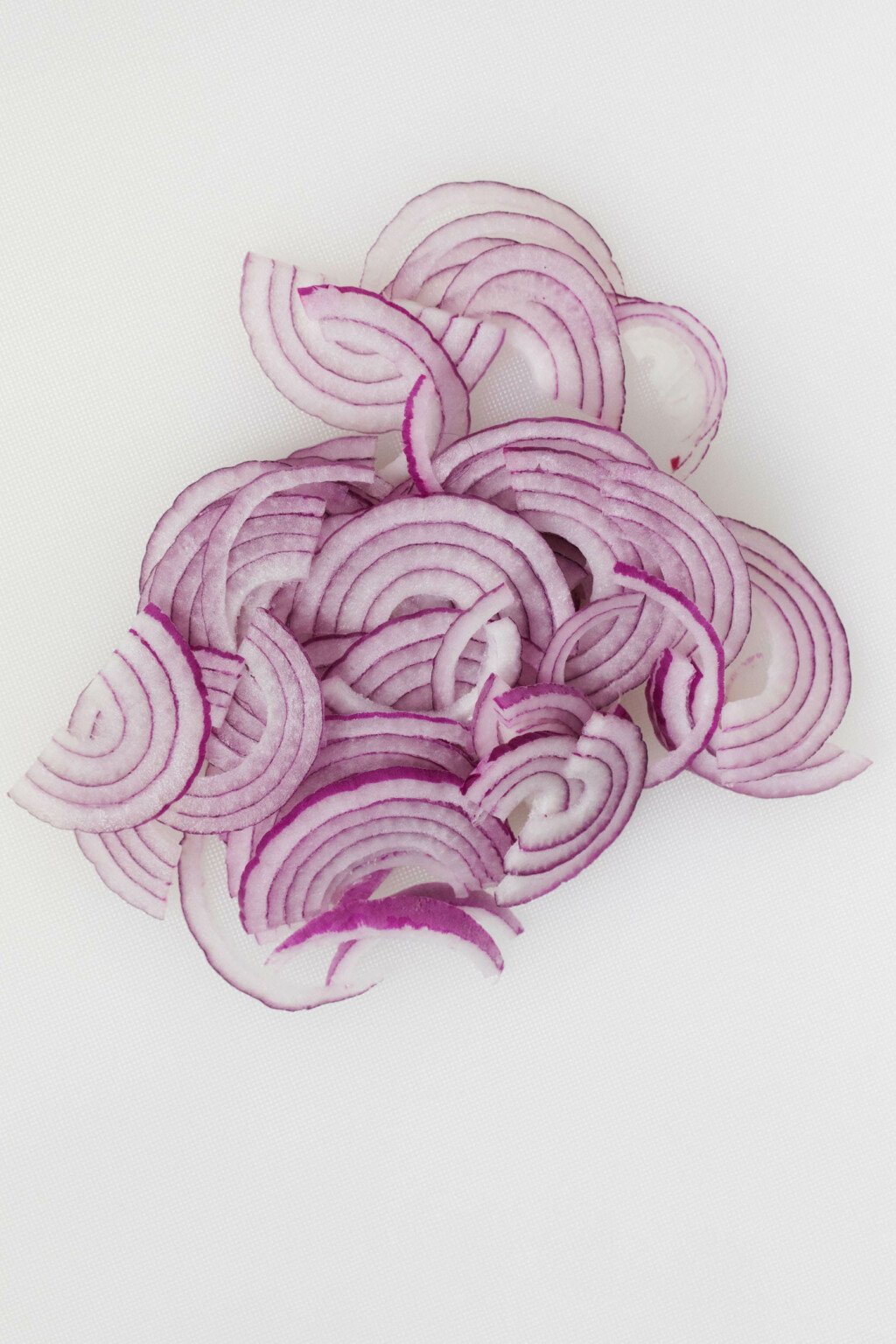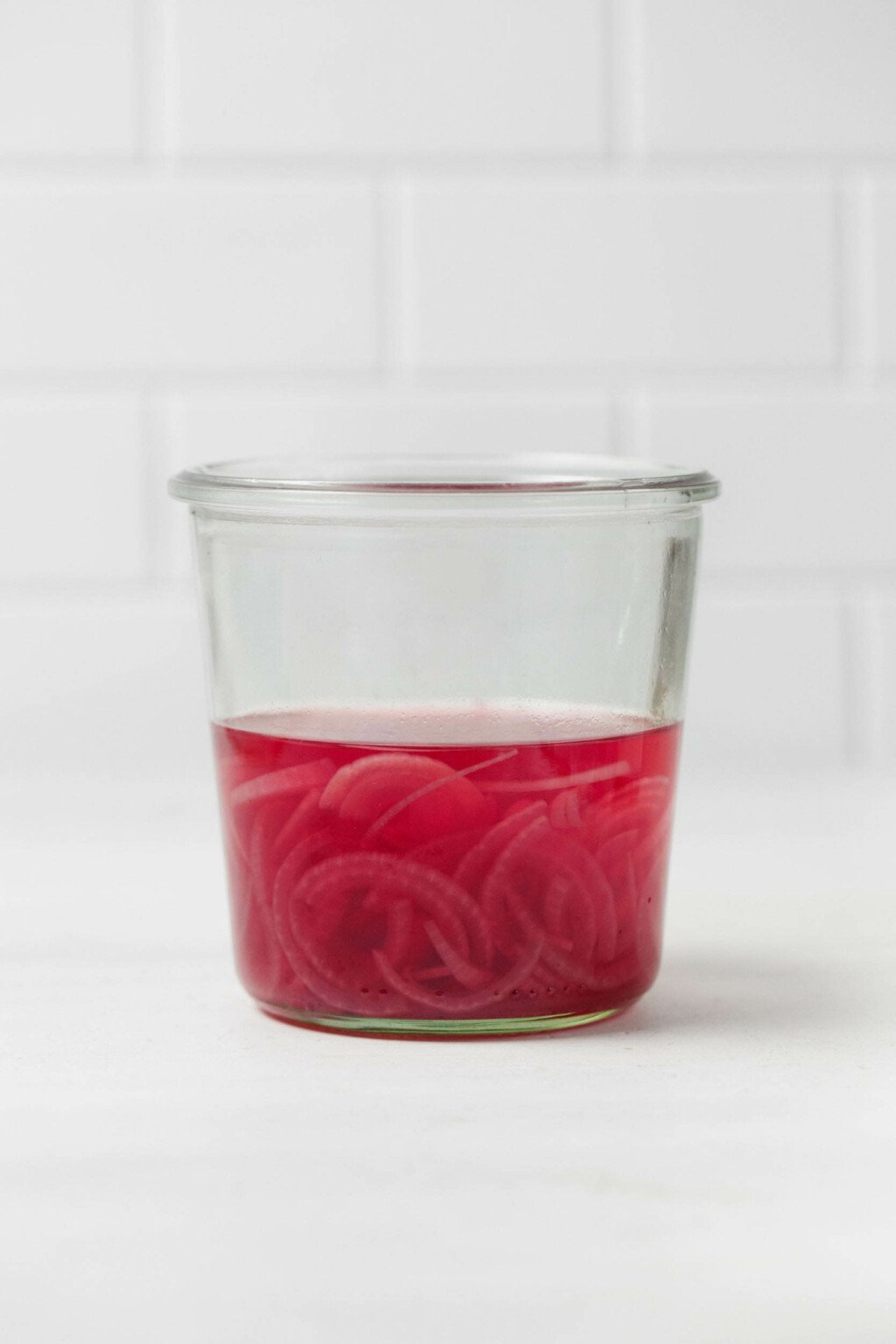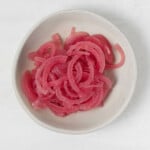Quick pickled onions add instant flavor to salads, bowls and sandwiches. They are an easy way to improve vegetarian meals! My go-to recipe takes only 10 minutes to prepare. It’s easy and reliable, and I share options for using it with other vegetables as well.

If last week involved any amount of holiday cooking, you may find yourself in need of a week off.
My Thanksgiving week didn’t actually involve any cooking. But it involved a sincere effort to slow down, take a few days off, and spend time with my mom.
For me, it means a break from the kitchen. I did a lot of defrosting work that was already at home. This included some vegan chicken, some bagels for sandwiches, a store-bought frozen pizza, and two burritos.
My freezer usually has some random bits of cooked grains, beans, tempeh, or tofu from last week’s vegetarian meal prep. These ingredients are easy to turn into simple vegan lunch bowls.
And those lunch bowls are better when quick pickled onions are involved.
If any ingredient deserves to be labeled as a flavor hack, it’s quickly pickled onions. They contribute to the acidity, saltiness and flavor of onions. However, they are much milder than raw onions, which can “repeat” one, as my mother used to say, hours after a meal.
I often mention quick pickled onions on this blog, but I have yet to share my go-to recipe. I’m fixing it today.
What are quick pickled onions?
Quick pickled onions are onions that have been soaked in an acidic pickling liquid and refrigerated until ready to eat.
Generally, quick pickled onions are thinly sliced before pickling.
What is the difference between quick pickling and long pickling?
What, exactly, makes quick pickled onions quick?
The designation “quick” refers to the fact that these onions are soaked in the pickling liquid, then transferred to the refrigerator.
In fact, quick pickling is sometimes called “refrigerator peeling” instead.
With traditional—that is, long—pickling, the pickles are put through a canning bath and then canned. They become shelf stable through canning, meaning they can be stored for longer periods of time.
On the other hand, quick-pickled onions, along with all quick-pickled vegetables, should be eaten within about 2-4 weeks. (Some guides say quick pickles keep up to 2 months, but I eat them sooner, just to be safe.)
Pickles need to be kept refrigerated throughout their storage period.
Here’s another “quick” thing about quick pickled onions: they’re quick to make!
Even fifteen minutes of pickling liquid, especially if that liquid is hot, will be enough to soften the onions, remove some of their “bite” and season a little.
The sooner you refrigerate pickled onions, the more flavorful they will be.
How do pickled onions taste?
Speaking of flavor, you can expect quick pickled onions to be just as pungent as regular onions.
However, they’ve got a less spicy quality than regular raw onions and I think they have less of an aftertaste.
Because quick pickled onions are made with an acidic pickling liquid, they tend to be tangy and sharp. Pickling liquid is salty, so onions can add saltiness to the dish.
You have the option of adding some sugar to the peeling liquid and I usually do. This helps offset all the vinegar used, and it can quickly give pickled onions a little sweetness.
How to make pickled onions quickly
My favorite thing about refrigerator pickling is how incredibly easy it is. There are only a few steps to zippy vegetable wellness.
Step 1: Slice your onion
You can use a food processor, mandolin, or a good, old-fashioned chef’s knife to thinly slice your onions for pickling.

Step 2: Making the peeling liquid
A quick pickling liquid is usually made from a combination of vinegar, water and salt.
Vinegar can be distilled white vinegar, apple cider vinegar, white wine vinegar or rice vinegar.
I usually use white vinegar or apple cider vinegar to make pickles. This recipe calls for apple cider vinegar, but you can use any of the above instead.
I think it is essential to use enough salt in liquid pickles. Salt will give character and flavor to the onion or any vegetable you choose for pickling.
Finally, I like to add a little sugar to my peeling liquid. I don’t add much, but the slight sweetness that the sugar gives helps balance out the flavor of the onion. You can omit the sugar in this recipe if you want.

To heat or not to heat?
I like to bring my pickling liquid to a boil before pouring it over my thinly sliced onions.
This is not an essential step in the process – technically, you can make quick pickles with cold pickling liquid. This is especially true if the quick pickle has plenty of time in the fridge. Over the course of the day, the pickling liquid will continue to soften and flavor your onions.
However, I think heating the peeling liquid does two things. First, it helps dissolve the salt and sugar in the vinegar and water.
Second, it helps soften and flavor your chopped onions right away. If you want to enjoy them soon after preparing them, it is best to use hot liquid.
When I make quick pickled onions with hot pickling liquid, I usually find they are ready to eat in 15 minutes. They won’t produce much flavor at that point, but they’ll still have a nice kick to contribute to dishes.
Step 3: Soak the onions
All you need to do in this step is to soak the onions in the pickling liquid.
The most important thing here is the container you keep the onions in.
I use a wide-mouthed 2 pint/950 ml mason jar to store onions. This is really more space than necessary, since onions shrink after pickling. But it doesn’t hurt to have some extra wiggle room.
If you’re using a small onion, you can get away with using a 1 pint/480ml jar, or something similar in size.
I have a jar funnel that I use when I pour my hot pickling liquid from a saucepan into mason jars. You don’t really need to use this; This is an easy way to prevent the spread.

Step 4: Store
At this point, you just need to cover your jar and transfer the onions to the fridge. There, they will keep their peeling fluid for 2-4 weeks.
Step 5: Enjoy
During the weeks that you have quick pickled onions in your fridge, you will be able to enjoy them in many ways.
Think: salads, grain bowls, burritos, tacos, wraps and more. I am sharing some specific recipe ideas below.
What kind of onion should I use?
That’s a good question!
Personally, I like to pickle red onions quickly. But I’ve made this same recipe many times with white or yellow onions, because I ran out of red. It always works and I always love the flavor of pickled onions.
I used the same recipe for pickled shallots when I ran out of onions. That works, too.
Can I use this recipe for other vegetables?
Most definitely.
You can use this same quick pickle recipe:
- sliced cucumber
- green beans
- Shaved carrot strips or thin carrot slices
- Chopped jalapeños
- chopped radish
- Cut beets
- Small cauliflower florets
As you can see, many vegetables make a great quick pickle.
Recipe suggestions
Below, you’ll find some vegan recipes I like to use for my quick pickled onions.
This list is by no means exhaustive. If you make onions and find you love them, I’d say add them to as many dishes as you like.
However, here are some foods that my pickled onions will find their way into, when I’m lucky enough to have a jar in my fridge.
salad
the bowl
Wraps and sandwiches
Grain and Bean Dishes
I could probably go on and on. But instead, I will share the recipe.

Production: 1 the cup
- 1 Red onion, medium size (You can also use white onion, yellow onion or shallot)
- 3/4 the cup the water
- 1/2 the cup Vinegar (Apple cider, white distilled, white wine and rice vinegar will all work)
- 1 1/2 teaspoon kosher salt
- 2 teaspoon sugarcane (optional)
If you’ve never made a quick pickle because you thought it might be difficult, I hope this post changes your mind!
More importantly, I hope it encourages you to try making this versatile veggie side/accompaniment. Once you get into the habit of eating pickled onions around, you’ll probably find that you want to add them to everything.
Onions are pretty nutrient-dense, so that’s a good thing!
Experiment, enjoy and let me know what you create.
xo

